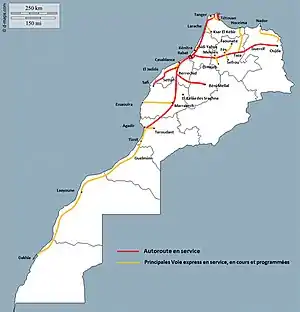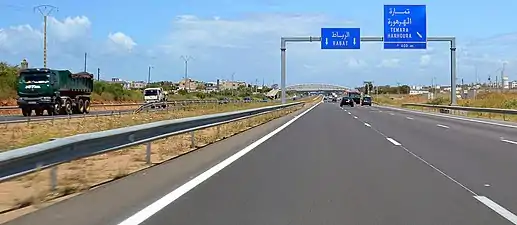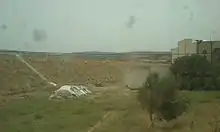Autoroutes of Morocco
Morocco's network of Motorways is administered by the state-owned company Autoroutes du Maroc (ADM). It runs the network on a pay-per-use basis, with toll stations placed along its length. The general speed-limit is 120 km/h.


History
The first expressway in the country is the A1 Casablanca-Rabat. Construction of the first section started in 1975 but completion of this road between the economic and the administrative capital took 13 years. Originally usage of the road was free of charge. The toll-road system was later introduced as one measure to prevent lengthy construction times (as happened with this first road). Finding investors for new roads would be easier when these roads would generate their own revenue to repay investors.[1]
Realized
In 2006, it was announced that ADM will be investing 6.18 billion dirhams ($859 million) to develop its highway network in 2007.[2] These investment packages are part of the objective that aim to complete 1,500 km by 2012.
As of August 2016, ADM manages 1808 km[3] of Morocco's toll roads.[4] As of November 2016 the total length of Morocco's motorways is 1,808 kilometres (paid) and 1,093 kilometres (free) expressways.[5]
Planned
The Kingdom of Morocco is planning investments of around €23 billion in road construction until 2035. The Moroccan government has announced that more than 5,500 kilometres of new highways and expressways are to be constructed with investment totalling €8.8 billion. This includes 700 km of 3x2 roads that will be constructed.
Also 45,000 km of new rural roads will be created in rural areas and the modernization of 7,000 km of rural roads. It is part of new plan of the Moroccan Ministry of Transport, which will invest 660 billion dirhams in the transport and logistics sector.
Completed roads


The main Moroccan expressways are:
- Rabat Ring Road (42 km)
- A1 Casablanca-Rabat (86 km)
- A1 Casablanca–Safi (255 km)
- A2 Rabat-Fes (190 km)
- A2 Fes-Oujda (306 km)
- A3 Casablanca-Marrakesh (220 km)
- A3 extension to Agadir (233 km)
- A4 Berrechid-Benni Mellal (172 km)
- A5 Rabat-Tangier Med (308 km)
- A7 Tetouan-Fnideq (28 km)
The construction history of these expressways by segment is as follows:[6][7]
| from | to | length in km |
construction period |
avg costs MDH/km |
notes | ||
|---|---|---|---|---|---|---|---|
| Casablanca | Rabat | 62 | forming the A3 motorway | ||||
| using: | Casablanca | Oued Cherrat | 33,5 | 1975–1978 | |||
| and: | Oued Cherrat | Rabat | 25.5 | 1983–1987 | |||
| Rabat | Larache | 150 | 13 | ||||
| using: | Rabat | Kénitra | 40 | 1993–1995 | |||
| and: | Kénitra | Larache | 110 | 1993–1996 | |||
| Larache | Sidi El yamani | 28 | 1996–1999 | ||||
| Sidi El yamani | Asilah | 15 | 2000–2002 | ||||
| Asilah | Tanger | 30 | 2002–2005 | ||||
| together forming the A1 Rabat-Tangier expressway | |||||||
| Rabat | Fès | 167 | 14.4 | ||||
| using | Rabat | Khemiset | 66 | 1996–1999 | |||
| and | Fes | Khemiset | 116 | 1995–1998 | |||
| Casablanca | Settat | 57 | 1998–2001 | 17.5 | |||
| Casablanca bypass | 27 | 2000–2004 | 25 | built in two phases | |||
| Casablanca | Safi | 255.5 | |||||
| using | Casablanca | Had Soualem | 16 | 2001–2004 | 18 | ||
| and | Had Soualem | Tnine Chtouka | 35 | 2002–2005 | 20 | ||
| and | Tnine Chtouka | El Jadida | 28 | 2004–2006 | 26 | ||
| and | El Jadida | Safi | 143 | 2012–2016 | 30 | ||
| Settat | Marrakesh | 162 | 2004–2007 | ||||
| Tanger-Med connector | 54 | 2004–2008 | 73 | ||||
| Tétouan | Fnideq | 28 | 2004–2008 | 36 | last 11 km opened 21-07-08 | ||
Road safety
In 2007 762 accidents with casualties were reported, a 5% increase on 2006. The accident-rate per 100 million traveled kilometers dropped by 20% from 30.2 to 24.1 between these years, but the total number as well as rate of deaths didn't go down.
A breakdown of these figures:[8]
| Type accident | 2006 | 2007 | % change | notes | |
|---|---|---|---|---|---|
| serious accidents | 726 | 762 | +5% | is accident with serious inj. or deaths | |
| rate per 100 mln km. | 30,2 | 24.1 | -20% | ||
| fatal accidents | 74 | 86 | +16% | is accident with at least one death | |
| rate per 100 mln km. | 3,1 | 2,7 | -12% | ||
| serious injuries | 480 | 535 | +11% | ||
| is per 100 mln km. | 20,0 | 16,9 | -15% | ||
| deaths | 90 | 127 | +41% | ||
| is per 100 mln km. | 3,7 | 4,0 | +7% | ||
Increasing road-safety
Increasing safety is an important goal for the ADM: the new autoroutes are designed to improve safety and the ADM also believes that extending the express-way network will increase overall safety as the through-going (and often high-speed) traffic is moved away from the Route Nationals, that run through the cities and villages along the way. Expressways also use non-level crossings and because there is no oncoming traffic overtaking cars is safer than on normal roads. The ADM also publishes accident figures to increase the attention of the public in road-safety.[9]
In the first quarter of 2011 the number of accidents on expressways with injuries fell 21% compared to the same period in 2010[10]
References and notes
- Website of ADM about its history Archived 2008-08-01 at the Wayback Machine, visited 4 August 2008.
- "Morocco strengthens infrastructural development". Archived from the original on July 20, 2011. Retrieved September 28, 2006.
- (in French)Moroccan infrastructures
- Overview main development figures on ADM site, visited september 2010.
- "Les voies express". Archived from the original on 2018-01-20. Retrieved September 3, 2018.
- Data obtained from key dates Archived 2012-03-07 at the Wayback Machine
- development program Archived 2008-08-18 at the Wayback Machine on ADM site as of 4 August 2008
- Official safety figures Archived 2012-03-08 at the Wayback Machine as reported by ADM, visited 3 August 2008
- ADM Website Detailed report on road-safety on expressways Archived 2011-09-29 at the Wayback Machine, PDF (French), retrieved 27 June 2011
- Newsarticle on ADM website 21% decrease in traffic accidents on motorways in Q1 2011 Archived 2011-06-13 at the Wayback Machine, visited 27 June 2011
External links
![]() Media related to Autoroutes in Morocco at Wikimedia Commons
Media related to Autoroutes in Morocco at Wikimedia Commons